Call of Duty Modern Warfare 2 (2022) PC performance guide: Best settings for high fps
Call of Duty Modern Warfare 2 (2022) is available now on PC. Here are the best settings to optimize your performance, along with XeSS, DLSS, and FSR testing.
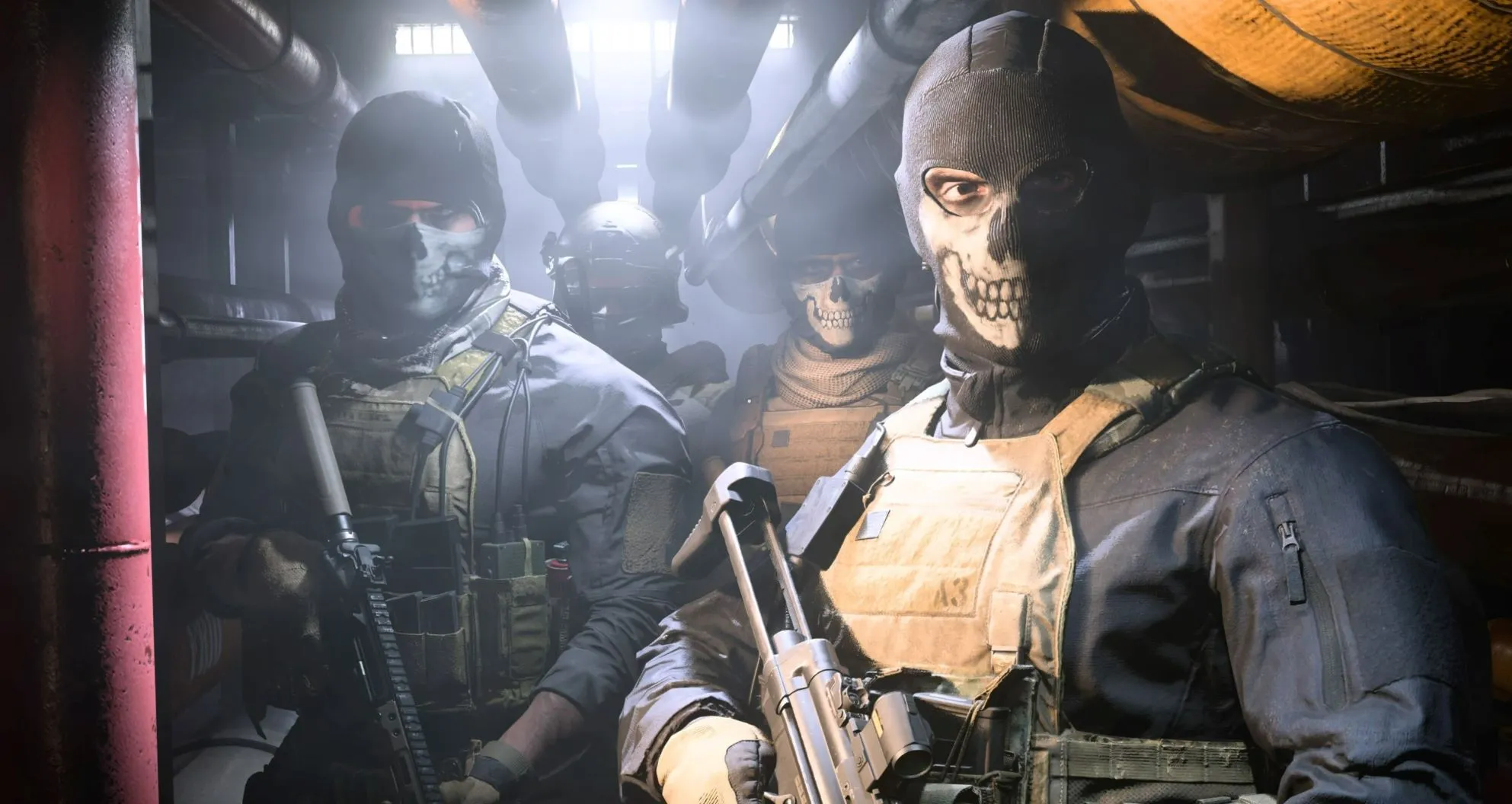
Call of Duty Modern Warfare 2, the 2022 reimagining, is here and available on PC. Like 2019’s Modern Warfare, the sequel is a masterclass in PC gaming tech and graphics, but it can still take a toll on your system. If you want the highest frame rates, you need the best settings for Call of Duty Modern Warfare 2.
I’ve spent the past week benchmarking the game, dialing in the best settings, and deciphering the differences between the game’s various upscaling modes. It’s a highly optimized game that can run on a wide range of hardware, but you’ll still need to tweak some graphics settings if you want a competitive frame rate.
I’m focusing on graphics settings here, but make sure to read our guide on the best settings for Call of Duty Warzone if you want to optimize your gameplay options.
Best settings for Call of Duty Modern Warfare 2 on PC
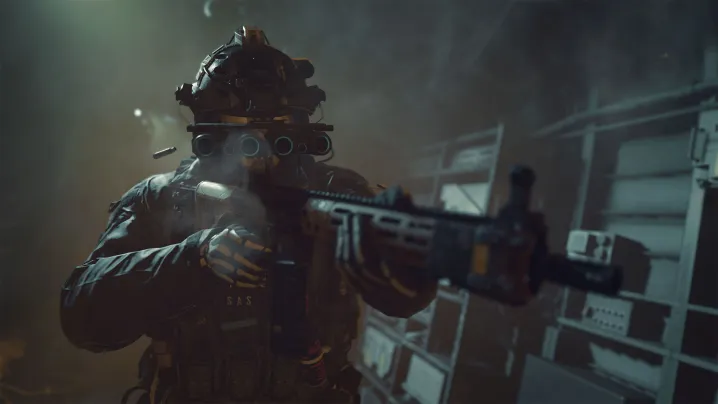
Call of Duty Modern Warfare 2 has a ton of graphics settings. Frankly, I recommend you stick with whatever settings the game recommends for your hardware. The recommendation system is pretty good, though it leans a bit heavier on performance than image quality. If you want to optimize, take a deep breath — here are the best settings for Call of Duty Modern Warfare 2:
Render resolution: 100 Anti-aliasing: Filmic SMAA T2X Anti-aliasing quality: High Video memory scale: 85 Texture resolution: High Texture filtering anisotropic: High Nearby level of detail: High Distant level of detail: Low Clutter draw distance: Short Particle quality: High Particle quality level: Normal Bullet impacts and sprays: On Shader quality: High Tessellation: Near Terrain memory: Max On-demand texture streaming: On Allocated texture cache size: 32 Streaming quality: Normal Volumetric quality: Medium Deferred physics quality: Low Water caustics: Off Shadow map resolution: Normal Screen space shadows: Low Spot shadow quality: Medium Cache spot shadows: On Particle lighting: Normal Ambient occlusion: Static objects (GTAO) GTAO quality: Normal Screen space reflections: Normal Weather grid volumes: On Weather grid volume quality: Normal Nvidia Reflex: On Depth of field: On World motion blur: Off Weapon motion blur: On Film grain on: 0.25That’s 38 settings, even before you get to any display settings or upscaling. Like Call of Duty Vanguard, you have a ton of bandwidth to optimize your performance, and a lot of settings to tinker with. The downside is that a lot of the settings don’t represent a big difference in performance, which can waste a lot when trying to dial the game to what you like.
Starting with the settings that don’t make a big difference, you can leave bullet impacts on (no difference in performance), as well as weapon motion blur. World motion blur is a hair more demanding, as is depth of field, but all three of these settings mostly come down to visual preference, not performance.
Image quality mainly hinges on texture quality, level of detail, anti-aliasing, and shadow resolution. Even at high texture quality, I pulled just over 5GB of video memory with these settings (much less than the recently released Uncharted Legacy of Thieves collection). Keep these settings high if you have above 4GB of video memory.
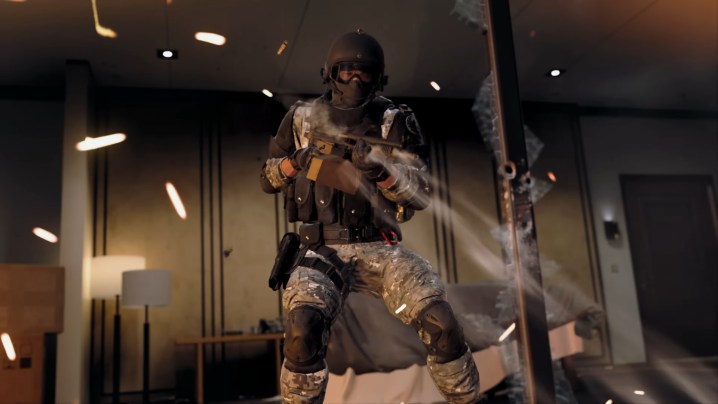
For anti-aliasing, you have the option between SMAA TX2 and “filmic” SMAA TX2, along with an associated quality level. Both combine SMAA with temporal super sampling (read our anti-aliasing explainer to see how these two approaches work), but the filmic version looks much better, so that’s what I recommend. It softens aliased edges, making them appear like they’re coming through the lens of a camera. If that’s not your jam, SMAA TX2 works, but it’s just as demanding as the filmic version.
Another interesting setting to call out is water caustics, which seems to use some form of ray tracing to recreate how light refracts in water. It can make a difference in the campaign, but I’m still recommending most people leave it off. Some reports say that it won’t work on GPUs without ray tracing hardware as well.
Finally, shader quality. I left this setting on high, though you can bump it down a tick if you’re running into performance issues. The important thing is to let Call of Duty Modern Warfare 2 compile shaders on your GPU. The game should do this automatically, but I recommend poking into the graphics settings and restarting shader optimization whenever you first load up the game and when you install a new graphics card driver.
Call of Duty Modern Warfare 2 PC system requirements
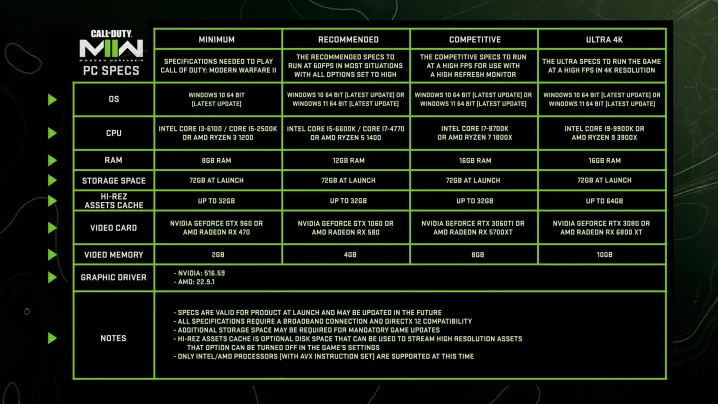 Activision Blizzard
Activision BlizzardCall of Duty Modern Warfare 2 comes with four sets of system requirements (similar to Marvel’s Spider-Man), but they’re a little vague. Each of the configurations gives you an idea about frame rate, but not resolution, which is the limiting factor in many cases. The benchmarks I’ll get to in the next section shed a bit of light on the resolutions the game is targeting, though.
Scalability is the name of the game, so you don’t need much to actually run Modern Warfare 2. At a minimum, the game calls for 2GB of video memory and four active threads, be those through Intel’s Hyperthreading or four physical cores on a first-gen Ryzen CPU. The game benefits from more cores, however, so I recommend a quad-core at minimum, with six cores being ideal.
On the graphics front, there’s a large disparity between the lower two configurations and the higher two. Make no mistake, Call of Duty Modern Warfare 2 is demanding on your GPU. However, with options to reduce VRAM load and multiple upscaling options, there are ways to squeeze out 60 fps even on aging hardware like the GTX 1060.
| Minimum | Recommended | Competitive | Ultra 4K | |
| Performance target | Required to play the game | 60 fps in most situations with high settings | High refresh rate monitions with high settings | High fps at 4K |
| CPU | Intel Core i3-6100 or AMD Ryzen 3 1200 | Intel Core i5-6600K or AMD Ryzen 5 1400 | Intel Core i7-8700K or AMD Ryzen 7 1600X | Intel Core i9-9900K or AMD Ryzen 9 3900X |
| GPU | Nvidia GTX 960 or AMD RX 470 | Nvidia GTX 1060 or AMD RX 580 | Nvidia RTX 3060 Ti or AMD RX 5700 XT | Nvidia RTX 3080 or AMD RX 6800 XT |
| Video memory | 2GB | 4GB | 8GB | 10GB |
| RAM | 8GB | 12GB | 16GB | 16GB |
| Operating system | Windows 10 | Windows 10/11 | Windows 10/11 | Windows 10/11 |
| Storage | 72GB (launch), 125GB | 72GB (launch), 125GB | 72GB (launch), 125GB | 72GB (launch), 125GB |
| Assets cache | Up to 32GB | Up to 32GB | Up to 32GB | Up to 64GB |
The more interesting point is storage, which is split between the space the game takes up and a high-resolution assets cache. The game lists 72GB and 125GB for storage space in different places (for what it’s worth, the game is currently taking up 55GB on my hard drive prior to the multiplayer and Warzone bits dropping). Storage space is dynamic with any Call of Duty release, though. Expect 100GB+ at launch and potentially up to 200GB as the game continues to receive updates. That’s not unheard of for a recent Call of Duty game, especially with Warzone installed.
You also have additional space taken up by the high-resolution assets cache. This is optional, and you can define how much space the cache takes. The game will stream in higher resolution textures as you play, given you’re connected to the internet (you need to be to play the game) and you have enough space. 32GB should be fine, even for 4K, but feel free to dedicate more space if you have the room to spare and you’re running at a high resolution.
One final note: The game requires a CPU with AVX instructions. Don’t confuse that with AVX-512, which has been recently publicized as a feature Intel disabled on its 12th-gen CPUs. AVX instructions are supported on nearly all CPUs released in the last decade, so if you meet the minimum CPU requirements, you’re fine.
Call of Duty Modern Warfare 2 PC benchmarks

Onto the benchmarks. I tested Call of Duty Modern Warfare 2 with the three most recent architectures from AMD, Intel, and Nvidia across 4K, 1440p, and 1080p. All of my tests were done with an Intel Core i5-13600K and 32GB of DDR5 memory. I also kept Resizable BAR turned on, as you should with most GPUs.
I kept upscaling off and used the optimized settings above as well, as it’s surprising how well these midrange cards held up. Even the least powerful GPU I tested, Intel’s Arc A750, was able to manage an average frame rate above 60 fps at 1440p, while the RTX 3070 could almost hit 60 fps at 4K. AMD’s RX 6600 XT did well, too, delivering frame rates capable of driving a high refresh rate monitor at 1080p.
One interesting note is the Arc A750’s 4K performance. It’s much closer to the RX 6600 XT than lower resolutions, which is a behavior I’ve seen with Arc in the past. It delivers better frame rates than it should as the resolution climbs, which allows the Arc A750 to compete with the RX 6600 XT at 4K, even when it’s clearly behind at lower resolutions.
It depends on the resolution and frame rate you’re targeting, but I’d recommend at least a GTX 1060 for 1080p if you want above 60 fps. An RTX 3060 Ti should deliver above 60 fps at 1440p, while you may need an RTX 3070 Ti to reach a stable frame rate at 4K. Thankfully, Modern Warfare 2 supports multiple upscaling features, so you have a lot of room to boost your frame rate even if you’re outside your performance target.
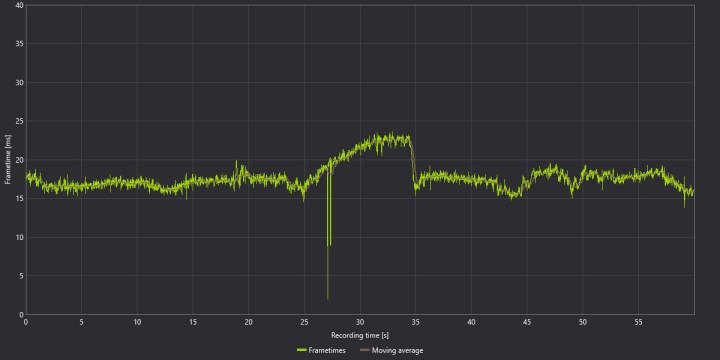
Onto frame times, you can see that Modern Warfare 2 is very stable. My benchmark run here with the RTX 3070 showed only one spike, indicating the game doesn’t have stuttering issues due to the engine like Gotham Knights showed. This is one reason why I recommend compiling the shaders on your GPU prior to playing the game. If you dive in without doing so, you’ll see some stutters as the shaders are optimized.
There are some interesting notes when you factor in upscaling, too.
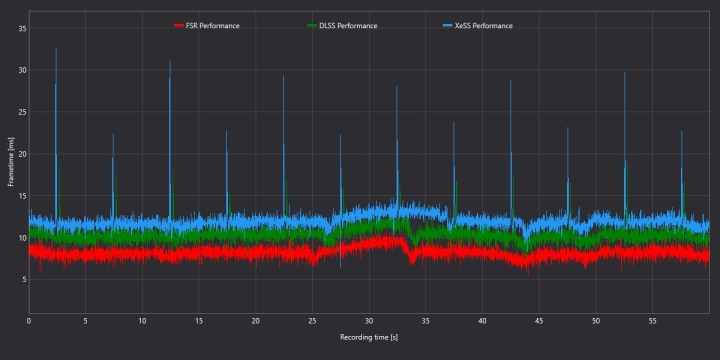
In Performance mode for FSR, DLSS, and XeSS, both DLSS and XeSS showed a brief spike in frame time every five seconds. The spikes were much higher with XeSS, though this data wasn’t gathered with an Intel Arc GPU (I’ll explain why in the next section). These spikes don’t ruin the experience of playing the game — most probably won’t even notice them — but it’s still interesting to dissect these frame time spikes to see where the upscaling needs to catch up.
XeSS, DLSS, and FSR in Call of Duty Modern Warfare 2
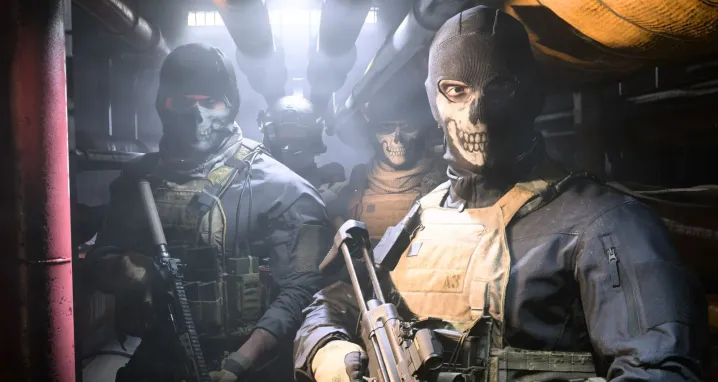
Call of Duty Modern Warfare 2 is packed with upscaling options. It supports Intel’s XeSS, Nvidia’s Deep Learning Super Sampling (DLSS), and AMD’s FidelityFX Super Resolution (FSR). There’s also an option for Nvidia Image Scaling (NIS) in the graphics menu, as well as built-in dynamic resolution option. Basically, anyone playing Modern Warfare 2 will have access to upscaling in some form or another.
They’re not all built equally, though. FSR is locked to its 1.0 version, which is much worse than FSR 2.0, and DLSS uses just the Super Resolution feature (not the Frame Generation feature available in DLSS 3 for the RTX 4090). Modern Warfare 2 supports a ton of upscaling options, which is great, but not all of them are using the latest and greatest versions.
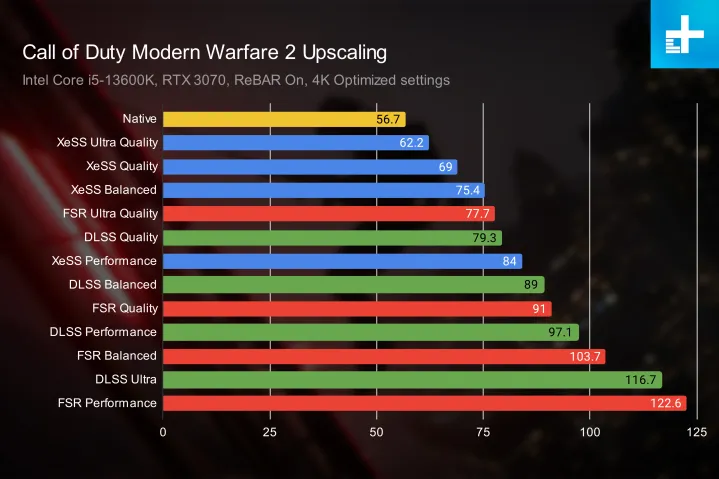
Above, you can see an overview of performance with the RTX 3070. With XeSS, keep in mind that it adapts to the hardware available. It runs its best with XMX cores on Intel Arc GPUs, and it will fall back to a simpler AI upscaling model when extra AI processing power isn’t available. Even with the RTX 3070, though, it’s quite a bit behind FSR and DLSS (which we also saw in Death Stranding and Shadow of the Tomb Raider).
I haven’t been able to test Intel Arc GPUs due to a strange bug on an earlier driver and build of the game. I haven’t seen any other reports of this issue, so it’s nothing you should worry about. But I’ll need to circle back to retest XeSS with proper XMX cores to see how it stacks up.
FSR beats out DLSS in performance at the more aggressive quality modes, but image quality suffers. As you can read in our FidelityFX Super Resolution review, the first iteration has some issues with image quality at the more aggressive presets, and those issues show up in Modern Warfare 2.

In the highest quality mode, DLSS wins out at preserving details in the grille toward the middle of the screen and the bricks on the buildings in the background. XeSS and FSR are just slightly behind here, though. Keep in mind that this is XeSS without the full benefit of Intel’s XMX cores.

The most aggressive quality mode shows larger differences. FSR is clearly the worst of the lot, as you can see with the soft leaves in the trees. XeSS is only a hair behind in native resolution, while DLSS looks a bit sharper due to the aggressive sharpening Nvidia applies. The windows behind the tree are more interesting, though. FSR fails to render the lines in the window, while XeSS and DLSS render them perfectly.
DLSS is the best option if you have access to it, both in terms of image quality and performance. Still, XeSS is a surprise hit here. It’s not nearly as performant as FSR, but it also maintains much better image quality, even without an Arc GPU. Hopefully, Modern Warfare 2 will get an FSR 2.0 patch eventually. Right now, FSR is a non-option in Modern Warfare 2 considering how many other upscaling options you have.

 Kass
Kass 































